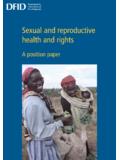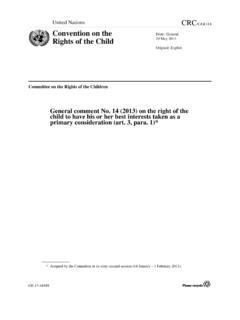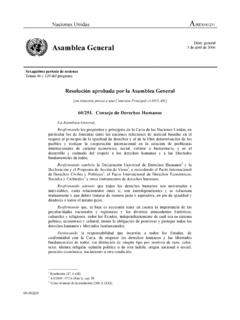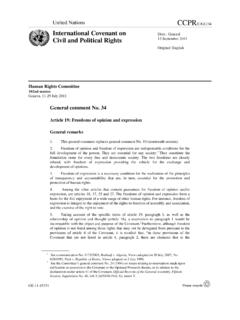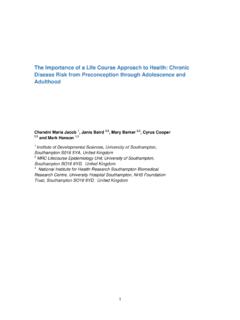Transcription of Sexual and reproductive health and rights
1 Sexual and reproductivehealth and rightsA position paperCover photo: Two women harvest vegetables from their plot in Kenya. Two babies sleeppeacefully. (Charlotte Thege/Still Pictures) Sexual and reproductivehealth and rightsA position paperPublished by the Department for International DevelopmentJuly 2004 Forewordby the Rt Hon Hilary Benn MPSecretary of State for International DevelopmentSexual and reproductive health is important to us all, at all stages of our lives. Yet far too manypeople are denied their right to Sexual and reproductive health . The vast majority are poor women,men and young people in developing of women and men lack access to contraception and to the Sexual and reproductive healthinformation and services they need to choose their family size and improve their own and theirchildren s life chances.
2 Millions more people are living with HIV and sexually transmitted infectionsthat could have been prevented or treated. Every minute a woman dies from a complication ofpregnancy or childbirth. Some 80 million women each year have unintended or unwantedpregnancies. For too many their only option is abortion in unsafe conditions. Women, especially, needmore choice and control over their Sexual and reproductive have been some gains. But not enough progress has been made since the 1994 InternationalConference on Population and Development agreed the goal of reproductive health for all by will make attaining the Millennium Development Goals much intend to keep at the forefront of the international debate on controversial issues and to supportcountry governments and partners to uphold everyone s right to Sexual and reproductive rights have their opponents who feel threatened by them and we must therefore continue toexplain why they are important and relevant to paper complements the UK s Call for Action on HIV and AIDS.
3 DFID s strategy on maternalmortality and our Target Strategy Papers on Better health for Poor People and Realising HumanRights for Poor People . We will use it as the basis for action and work with our partners, and I hopeyou will find it BennJuly 2004iiiContentsForewordiiiSummary1 Chapter 1: Introduction3 Why are Sexual and reproductive health and rights important?3 What do we mean by Sexual and reproductive health and rights ?4 Chapter 2: What is the scale of the problem?6 Chapter 3: What can be done?10 Chapter 4: What progress has been made?15 Chapter 5: What is DFID s position?17 Advocacy and partnership17 Improving access to Sexual and reproductive health services19 Addressing social, cultural and economic barriers to 20reproductive healthGenerating and applying knowledge21 Chapter 6: Conclusion: Where do we go from here?
4 22 References23ivSummarySexual and reproductive health is a human right, essential to human development and toachievement of the Millennium Development Goals. DFID is firmly committed to the Programme ofAction of the International Conference on Population and Development and will continue to supportgovernments and partners to achieve reproductive health for all by people, especially women and young people, face huge social and economic barriers to sexualand reproductive health . 120 million couples do not have access to the family planning services andcontraception they need. Every year, 529,000 women die from complications of pregnancy andchildbirth and 3 million children die in the first week of life.
5 38 million people are currently livingwith HIV and 340 million people contract sexually transmitted infections each year. Most paper sets out DFID s position on Sexual and reproductive health and rights and our view ofthe future. It forms the basis for planning our investment and activities and our work with have seen considerable achievements since the I994 International Conference on Population andDevelopment set goals and targets on reproductive health and rights for all by 2015. Countries haveturned ICPD commitments into policies and action, increased access to a range of family planningoptions, and in some countries cut maternal deaths. But faster progress is needed.
6 We face newchallenges, in particular the devastating impact of HIV and AIDS and the biggest ever population ofyoung people entering their reproductive years. Demand for Sexual and reproductive health servicesand commodities will continue to grow. health systems remain weak in many countries, and aredeteriorating in some. There are too few health workers particularly in the poorest areas. We couldmake more use of opportunities to integrate HIV and Sexual and reproductive health services in waysthat respond better to people s will work with country governments and partners to: advocateinternationally and nationally for policies and resources that address people s rightsto Sexual and reproductive health , and continue to address controversial issues such as safeabortion and harmful and coercive practices; improve access to comprehensive services,that are responsive to the rights and needs ofpoor people and other vulnerable groups.
7 Address social cultural and economic barriers,using a rights -based approach, and tacklingissues outside the health sector; and support research, monitoring and evaluation and apply knowledge and lessons learntinpolicy and aim is to achieve the following outcomes: Improved maternal and newborn health . Accessible, high quality family planning choices. Elimination of unsafe abortion. Reduced incidence of HIV and sexually transmitted infections. Greater awareness of Sexual health and reduced risky behaviour. Gender equality, rights , accountability and equity realised goals of the International Conference on Population and Development (ICPD) of 19941,2provide the foundation for many of the Millennium Development Goals.
8 We have seen real progresstowards the target it set of universal access to reproductive health services by 2015. Important gainshave been made over the last decade in Sexual and reproductive health and rights , with a renewedfocus on women s needs. But there are threats to these gains and much more work to be done tomeet the goals and paper reviews and updates DFID s position on Sexual and reproductive health and following sections review the current situation, describe challenges ahead, and set out DFID sview of the future. We will use the paper as the basis for planning our continued contribution toachieving the ICPD goals. It also communicates to our partners our continuing commitment andapproach to achieving those are Sexual and reproductive health and rights important?
9 And reproductive health is an essential element of good health and humandevelopment. But we need more progress on Sexual and reproductive health to meet many of theMillennium Development Goals (MDGs), particularly those concerned with child and maternal health ,HIV and AIDS and other communicable diseases, and gender equality. Better Sexual and reproductivehealth will also accelerate progress towards the MDGs on eradicating extreme poverty and hunger,and achieving universal primary people s rights to Sexual and reproductive health would help meet the MDGs inmany ways. Most maternal and newborn deaths could be prevented by improved access to well-integrated reproductive health services, including antenatal care, skilled attendance during childbirthand immediately after birth, and emergency obstetric care for complications.
10 Family planning andmodern contraception offer choice and opportunity for women to make informed decisions and havemore control over their lives. Enabling young women to avoid pregnancy too early in life, when theyare at much greater risk of complications, reduces maternal and child deaths. Better spacing of birthsreduces child mortality and improves maternal health . Sexual and reproductive health informationand services are essential to efforts to prevent HIV and and reproductive health is also important as an issue in itself. People have the right tomake their own choices and decisions, based on sound information. Improving Sexual andreproductive health is among the most cost-effective of all development investments, reapingpersonal, social and economic benefits.
